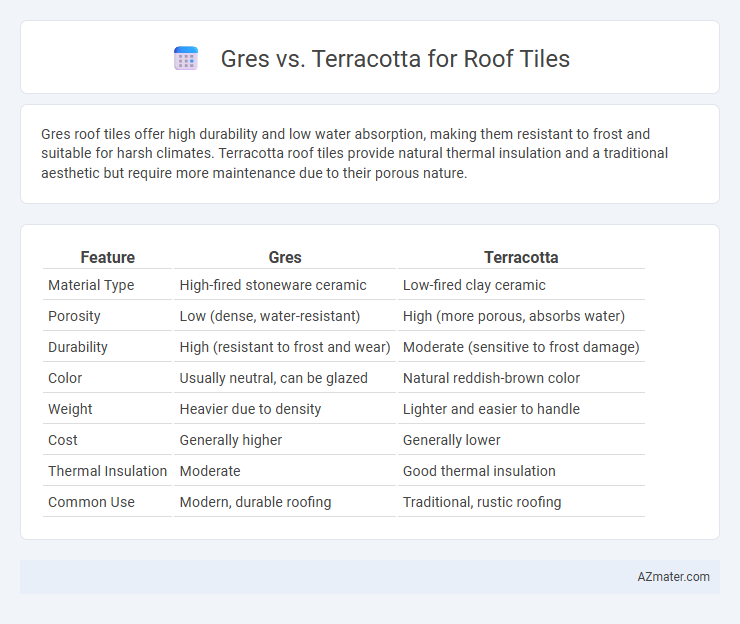Gres roof tiles offer high durability and low water absorption, making them resistant to frost and suitable for harsh climates. Terracotta roof tiles provide natural thermal insulation and a traditional aesthetic but require more maintenance due to their porous nature.
Table of Comparison
| Feature | Gres | Terracotta |
|---|---|---|
| Material Type | High-fired stoneware ceramic | Low-fired clay ceramic |
| Porosity | Low (dense, water-resistant) | High (more porous, absorbs water) |
| Durability | High (resistant to frost and wear) | Moderate (sensitive to frost damage) |
| Color | Usually neutral, can be glazed | Natural reddish-brown color |
| Weight | Heavier due to density | Lighter and easier to handle |
| Cost | Generally higher | Generally lower |
| Thermal Insulation | Moderate | Good thermal insulation |
| Common Use | Modern, durable roofing | Traditional, rustic roofing |
Introduction to Roof Tile Materials
Gres and terracotta are two popular materials used for roof tiles, each offering distinct advantages in durability and aesthetics. Gres tiles are made from high-fired clay, resulting in a dense, water-resistant surface ideal for harsh weather conditions. Terracotta, a natural clay product known for its warm, earthy tones, provides excellent breathability and traditional charm, making it a preferred choice for Mediterranean and rustic architectural styles.
What is Gres?
Gres, a type of high-density porcelain stoneware, is known for its durability, low water absorption, and resistance to frost, making it an excellent choice for roof tiles in various climates. Compared to terracotta, gres tiles offer superior strength and longevity due to their compact, vitrified structure, which also provides a sleek, contemporary appearance. These properties make gres a preferred material for roofing where weather resistance and low maintenance are key priorities.
What is Terracotta?
Terracotta is a traditional clay-based ceramic material used for roof tiles, characterized by its natural reddish-brown color and porous texture that offers excellent breathability and insulation. Unlike gres tiles, which are made from dense, vitrified stoneware for enhanced durability and water resistance, terracotta tiles provide a classic aesthetic favored for Mediterranean and rustic architectural styles. Their natural composition allows for effective temperature regulation, making terracotta a sustainable roofing choice in warm climates.
Durability: Gres vs Terracotta
Gres roof tiles, made from dense, high-fired clay, exhibit superior durability and resistance to weathering compared to traditional terracotta tiles. Terracotta tiles, while aesthetically appealing with their natural reddish hue, tend to be more porous and susceptible to cracking under extreme temperature fluctuations. The enhanced strength and low water absorption rate of gres make it a preferred choice for long-lasting roofing solutions in diverse climates.
Weather Resistance Comparison
Gres roof tiles exhibit superior weather resistance due to their dense, vitrified clay composition, making them highly resistant to frost, heavy rain, and UV radiation. Terracotta tiles, while offering good natural insulation and breathable qualities, tend to be more porous and susceptible to water absorption, which can lead to erosion or cracking in extreme weather conditions. For long-term durability in varied climates, gres tiles provide enhanced protection against moisture and temperature fluctuations compared to traditional terracotta.
Aesthetic Differences
Gres roof tiles offer a sleek, uniform appearance with a smooth surface and consistent color, ideal for modern or minimalist architectural styles. Terracotta tiles present a warm, rustic charm with natural earthy tones and a textured finish, often featuring variations that enhance traditional or Mediterranean aesthetics. The choice between gres and terracotta directly impacts the visual character of a roof, influencing the overall style and ambiance of a building.
Installation Process and Challenges
Gres roof tiles, made from dense, high-fired ceramic, demand precise installation due to their weight and rigidity, requiring strong support structures and skilled labor to avoid cracking during handling. Terracotta tiles, crafted from natural clay and often lighter, allow easier cutting and fitting but pose challenges with fragility and susceptibility to weathering, necessitating careful handling and proper sealing during installation. Both materials require expertise to ensure proper alignment and water drainage, with gres tiles offering enhanced durability but more complex installation, while terracotta provides aesthetic versatility but may incur higher maintenance over time.
Cost Analysis: Gres vs Terracotta Tiles
Gres roof tiles generally cost more upfront than terracotta tiles, with prices ranging from $4 to $8 per square foot compared to terracotta's $3 to $6. Despite higher initial expenses, gres tiles offer superior durability and lower maintenance costs over time, which can translate to long-term savings. Terracotta tiles, while more affordable initially, may require frequent repairs or replacement in harsh climates, increasing overall lifecycle costs.
Maintenance and Longevity
Gres roof tiles possess high-density ceramic composition, making them extremely durable and resistant to weathering, which results in minimal maintenance requirements and a lifespan exceeding 50 years. Terracotta tiles, crafted from natural clay, offer excellent thermal properties and an attractive finish but require regular sealing and inspections to prevent cracking and water absorption, typically lasting around 30-50 years. Both materials benefit from professional installation and periodic cleaning, but gres tiles generally provide longer-term cost efficiency due to their superior resistance to moisture, frost, and mechanical wear.
Which is Better for Your Roof?
Gres tiles offer superior durability and resistance to weathering compared to terracotta, making them an excellent choice for roofs in harsh climates. Terracotta tiles provide a natural aesthetic with excellent thermal insulation but may require more maintenance due to their porosity. For long-term performance and low maintenance, gres tiles are generally better suited for roofing applications.

Infographic: Gres vs Terracotta for Roof Tile
 azmater.com
azmater.com